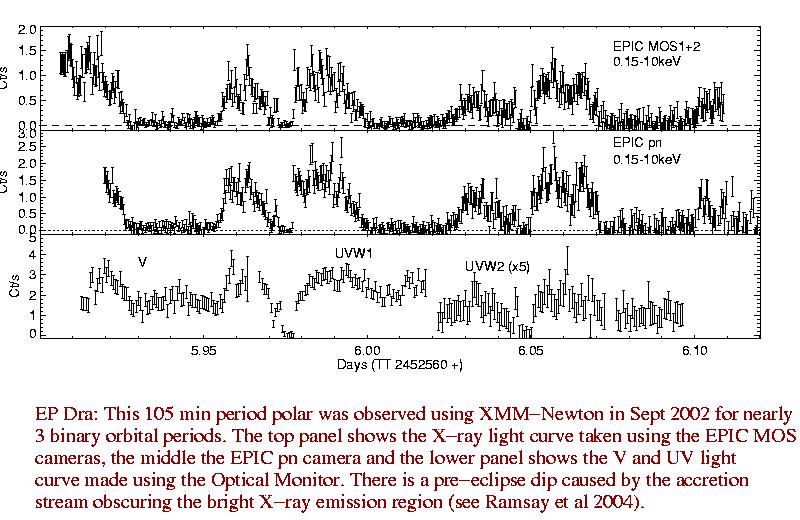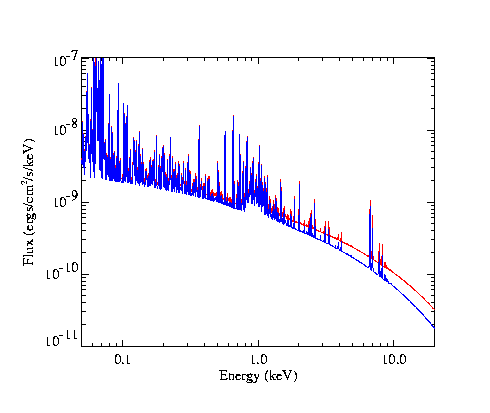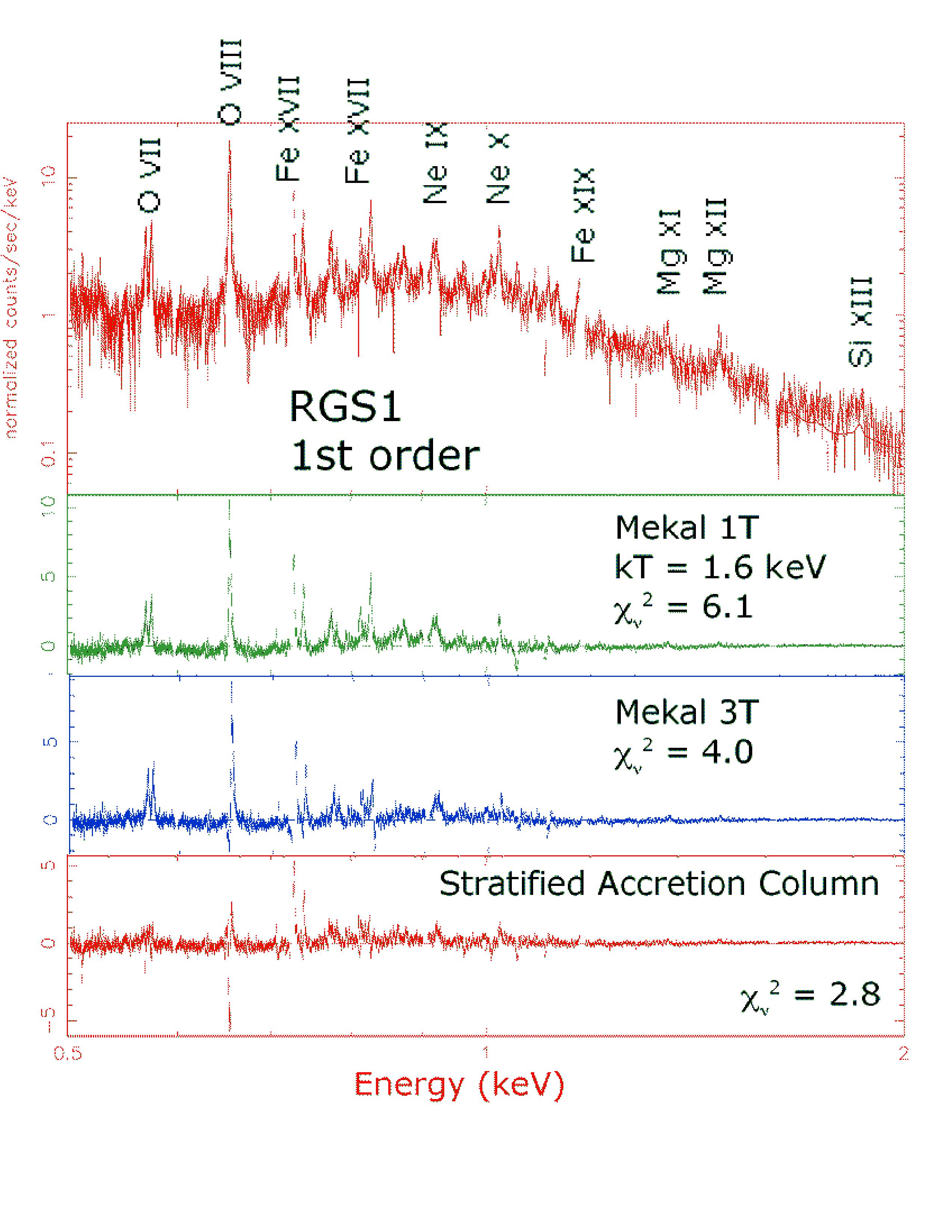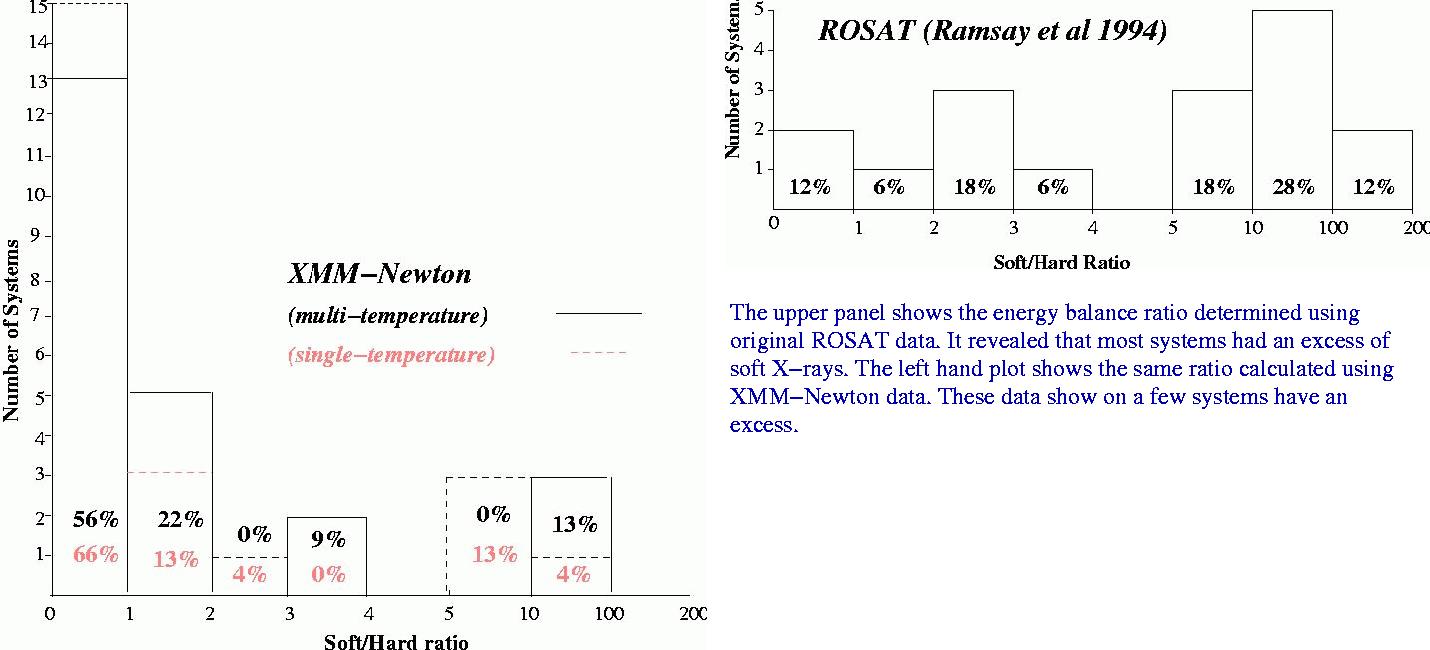X-ray observations of polars
Polars or AM Her systems are accreting binary systems in which
material transfers from a dwarf secondary star onto a magnetic
(B~10-200MG) white dwarf through Roche lobe overflow. For polars in a
high accretion state, the accretion flow forms a strong shock at some
height above the photosphere of the white dwarf. The maximum
temperature in the post-shock flow is set by the mass of the white
dwarf. For a 0.7Msun white dwarf the shock temperature is ~30keV, with
the temperature decreasing as the gas settles onto the white
dwarf. Some fraction of the hard X-rays intercept the photosphere of
the white dwarf, are thermalised and then re-radiated as soft X-rays
or in the extreme UV. Polars, are ideal targets with which to
investigate the accretion process in detail.
We have undertaken a survey of polars using XMM-Newton. This
survey contains observations of 37 polars -- more than half of all
known systems. Our survey has led to various papers on individual
systems, which concentrated on phase resolved spectroscopy, as well as
papers which have looked at the energy balance of these systems and
those systems which were observed in low accretion states. Copies of
our papers can be found in our pre-print
web page.
X-ray light
curves
The X-ray light curves of polars allow us to determine the system
geometry of these objects. Further, by comparing the soft and hard
X-ray light curves we can obtain insight into the location of the
accretion stream - which preferentially absorbs softer X-rays. One
interesting example is the eclipsing system EP Dra. In this system,
the main accretion comes into and out of view as the binary system
rotates on its 105 min binary orbital period.


Prior to these X-ray observations, we obtained optical data of EP Dra
using the
Superconducting Tunneling Junction (STJ) array on the WHT . From
that data we predicted that the accretion stream attaches onto a wide
range of magnetic field lines and that this would result in soft
X-rays being preferentially absorbed in the phase interval before the
eclipse
(Bridge et al 2002) . The X-ray observations (above) confirm this
prediction, showing that in this system, soft X-rays start to be
obscured shortly after the start of the bright phase. Further, there
is a dense core of material in the accretion stream. See
XMM-Newton observations of the eclipsing polar EP Dra (Ramsay
et al 2004) for details
X-ray spectra
It is important for understanding the accretion physics to clarify the
relationship between the different emission, absorption and reflection
components in these systems, and their dependence on the bolometric
luminosity. At MSSL we have therefore begun the process of modelling
the X-ray emission from mCVs in much more detail. This has entailed
the construction of optically thin bremsstrahlung and line spectra
from the multi-temperature cooling flow of material as it settles onto
the surface of the white dwarf. The temperature structure takes into
account the additional cooling at each point resulting from the
cyclotron emission from electrons spiralling in the intense magnetic
field. In addition, the contribution of the Compton reflection from
the surface of the white dwarf is included. The two spectra in the
figure below indicate the difference between the emitted flux for a
typical 40 MegaGauss magnetic field and one with zero
field.

We show below the difference in
the fits to the XMM-Newton RGS spectra of the intermediate polar EX
Hya using our 'stratified accretion column' model and those models
which are usually used to fit X-ray spectra. Our stratified model
provides a significantly better fit than that obtained by using a
3-temperature thermal plasma model.

The X-ray energy balance
Using the most physical model for the emission region is very
important when determining the ratio of the reprocessed component and
the shocked component. In the EXOSAT and ROSAT eras a significant
number of polars were found to show a soft/hard X-ray ratio much
greater than that expected from the standard accretion shock
model. This was known as the `soft X-ray excess'. We have made an
snapshot survey of polars using XMM-Newton and determined their
soft/hard ratios. We find that less than one in five of systems show a
significant soft X-ray excess, while the rest show ratios consistent
with that predicted by the standard model. We have investigated the
discrepancy between this and the previous investigations by
re-examining all the available ROSAT PSPC pointed observations of
polars using more recent calibrations than in the original studies.
We find that these data show an energy balance ratio which is broadly
consistent with that of our XMM-Newton results. We conclude that the
previous studies were affected by the data being less well
calibrated. We discuss which physical mechanisms might give rise to a
high soft X-ray excess and whether systems with high ratios show more
variation in soft X-rays. Surprisingly, we find that 6 out of 21
systems found in a high accretion state did not show a distinct soft
X-ray component. Two systems showed one pole with such a component and
one which did not. Based on the ratio of the observed soft X-ray to UV
flux measurements (which were obtained simultaneously using the
Optical Monitor) we suggest that this is because the reprocessed
component in these systems is cool enough to have moved out of the
soft X-ray band and into the EUV or UV band. See
The energy balance of polars revisited (Ramsay &
Cropper 2004) for details

Those systems in a low accretion state
Off the 37 polars which were observed as part of our XMM-Newton
survey, we found that 16 of these systems were in a low, or much
reduced, accretion state. Of those, 6 were not detected in
X-rays. This suggests that in any survey of polars, around half will
be in a low accretion state. We tested if there was a bias towards
certain orbital periods: this is not the case. Of the 10 systems which
were detected at low, but significant rates in X-rays, 8 showed
significant variability in their X-ray light curves. This implies that
non-uniform accretion still takes place during low accretion
epochs. The bolometric luminosity of these systems is ~10^30 ergs/s,
two orders of magnitude less than for systems in a high accretion
state. The X-ray spectra show no evidence of a distinct soft X-ray
component. However, the X-ray and UV data imply that such a low
temperature component exists: its temperature is low enough for its
flux distribution to move outside the bandpass of the X-ray
instruments. See
XMM-Newton observations of polars in low accretion states
(Ramsay et al 2004) for details
Gavin Ramsay (Aug 2004)





